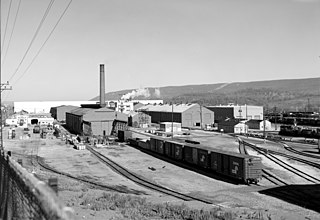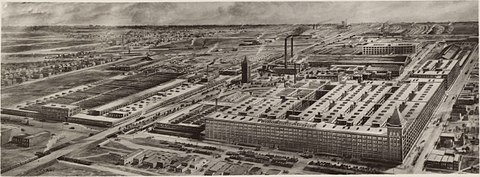
SS Eastland was a passenger ship based in Chicago and used for tours. On 24 July 1915, the ship rolled over onto its side while tied to a dock in the Chicago River. In total, 844 passengers and crew were killed in what was the largest loss of life from a single shipwreck on the Great Lakes.
Hawthorne often refers to the American writer Nathaniel Hawthorne.

Cicero is a suburb of Chicago and an incorporated town in Cook County, Illinois, United States. Per the 2020 census, the population was 85,268, making it the 11th largest municipality in Illinois. The town of Cicero is named after Marcus Tullius Cicero, a Roman statesman and orator.
The Western Electric Company was an American electrical engineering and manufacturing company officially founded in 1869. A subsidiary of the American Telephone and Telegraph Company for most of its lifespan, it served as the primary equipment manufacturer, supplier, and purchasing agent for the Bell System from 1881 until 1984, when the system was dismantled. The company was responsible for many technological innovations, as well as developments in industrial management.

George Elton Mayo was an Australian born psychologist, industrial researcher, and organizational theorist. Mayo was formally trained at the University of Adelaide, acquiring a Bachelor of Arts Degree graduating with First Class Honours, majoring in philosophy and psychology, and was later awarded an honorary Master of Arts Degree from the University of Queensland (UQ).
The Hawthorne effect is a type of human behavior reactivity in which individuals modify an aspect of their behavior in response to their awareness of being observed. The effect was discovered in the context of research conducted at the Hawthorne Western Electric plant; however, some scholars think the descriptions are fictitious.
Automatic Electric Company was an American telephone equipment supplier primarily for independent telephone companies in North America, but also had a worldwide presence. With its line of automatic telephone exchanges, it was also a long-term supplier of switching equipment to the Bell System, starting in 1919. The company was the largest manufacturing unit of the Automatic Electric Group. In 1955, the company was acquired by General Telephone and Electronics (GT&E). After numerous reorganization within GTE, the companies assets it came under the umbrella of Lucent in the 1990s, and subsequently part of Nokia.
Zenith Electronics, LLC, is an American research and development company that develops ATSC and digital rights management technologies. It is owned by the South Korean company LG Electronics. Zenith was previously an American brand of consumer electronics, a manufacturer of radio and television receivers and other consumer electronics, and was headquartered in Glenview, Illinois. After a series of layoffs, the consolidated headquarters moved to Lincolnshire, Illinois. For many years, their famous slogan was "The quality goes in before the name goes on". LG Electronics acquired a controlling share of Zenith in 1995; Zenith became a wholly owned subsidiary in 1999. Zenith was the inventor of subscription television and the modern remote control, and was the first to develop high-definition television (HDTV) in North America.

Graybar Electric Company, Inc. is an American wholesale electrical, communications and data networking products distribution business, which also supplies related supply-chain management and logistics services. Based in Clayton, Missouri, the employee-owned corporation is included on the Fortune 500 list of the largest United States corporations.
Stromberg-Carlson was a United States telecommunications equipment and electronics manufacturing company. It was formed in 1894 as a partnership by Swedish immigrants Alfred Stromberg and Androv Carlson. It was one of five companies that controlled the national supply of telephone equipment until after World War II.

Fritz Jules Roethlisberger was a social scientist and management theorist at the Harvard Business School.
Western Electric's Reading Works in Berks County, Pennsylvania was a manufacturer of integrated circuit and optoelectronic equipment for communication and computing. The work force grew to nearly 5,000 by 1985 making the Reading, Pennsylvania, facility one of Berks County's largest industrial employers. As a part of Western Electric and the Bell System, it changed its masthead many times during its life.

St. Mary of Częstochowa in Cicero is an historic church of the Archdiocese of Chicago located in Cicero, Illinois.

Joseph Moses Juran was a Romanian-born American engineer, management consultant and author. He was an advocate for quality and quality management and wrote several books on the topics. He was the brother of Academy Award winner Nathan Juran.

The Kellogg Switchboard and Supply Company was an American manufacturer of telecommunication equipment. Anticipating the expiration of the earliest, fundamental Bell System patents, Milo G. Kellogg, an electrical engineer, founded the company in 1897 in Chicago to produce telephone exchange equipment and telephone apparatus.

A continual improvement process, also often called a continuous improvement process, is an ongoing effort to improve products, services, or processes. These efforts can seek "incremental" improvement over time or "breakthrough" improvement all at once. Delivery processes are constantly evaluated and improved in the light of their efficiency, effectiveness and flexibility.

Altoona Works is a large railroad industrial complex in Altoona, Pennsylvania. It was built between 1850 and 1925 by the Pennsylvania Railroad (PRR), to supply the railroad with locomotives, railroad cars and related equipment. For many years, it was the largest railroad shop complex in the world.
The Manufacturers' Junction Railway is a shortline railroad in Cicero, Illinois. Originally a subsidiary of Western Electric used to switch their Hawthorne Works, after the plants were phased out it was sold to OmniTRAX, a company offering railroad management and other services.

River Works, formerly known as Air Force Plant 29, is a plant of General Electric's aviation division located in Lynn, Massachusetts. It is serviced by the River Works station on the MBTA's Newburyport/Rockport Line. It was purchased by General Electric in 1983 from the United States Air Force.

Sprague Electric Company was an electronic component maker founded by Robert C. Sprague in 1926. Sprague was best known for making a large line of capacitors used in a wide variety of electrical and electronic in commercial, industrial and military/space applications. Other products include resistive components, magnetic components, filter assemblies, semiconductors and integrated circuits.














